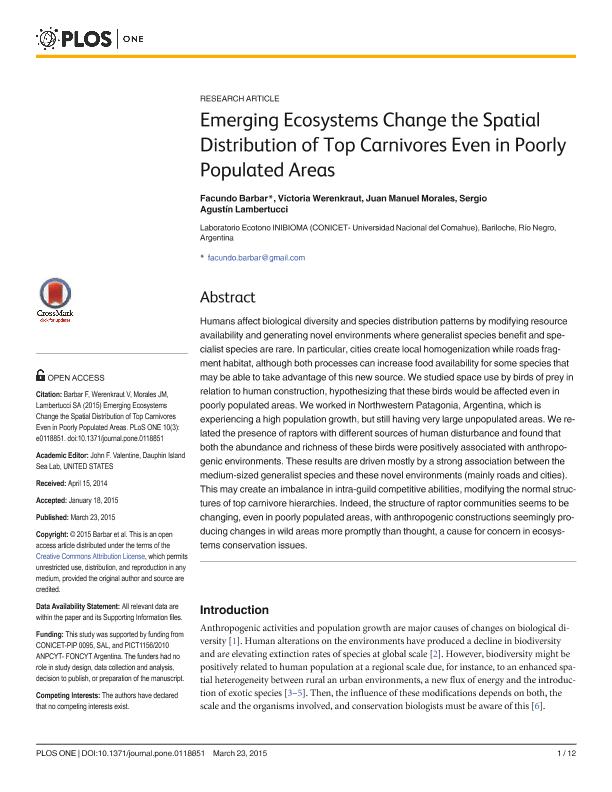Artículo
Emerging Ecosystems Change the Spatial Distribution of Top Carnivores Even in Poorly Populated Areas
Fecha de publicación:
03/2015
Editorial:
Public Library Of Science
Revista:
Plos One
ISSN:
1932-6203
Idioma:
Inglés
Tipo de recurso:
Artículo publicado
Clasificación temática:
Resumen
Humans affect biological diversity and species distribution patterns by modifying resource availability and generating novel environments where generalist species benefit and specialist species are rare. In particular, cities create local homogenization while roads fragment habitat, although both processes can increase food availability for some species that may be able to take advantage of this new source. We studied space use by birds of prey in relation to human construction, hypothesizing that these birds would be affected even in poorly populated areas. We worked in Northwestern Patagonia, Argentina, which is experiencing a high population growth, but still having very large unpopulated areas. We related the presence of raptors with different sources of human disturbance and found that both the abundance and richness of these birds were positively associated with anthropogenic environments. These results are driven mostly by a strong association between the medium-sized generalist species and these novel environments (mainly roads and cities). This may create an imbalance in intra-guild competitive abilities, modifying the normal structures of top carnivore hierarchies. Indeed, the structure of raptor communities seems to be changing, even in poorly populated areas, with anthropogenic constructions seemingly producing changes in wild areas more promptly than thought, a cause for concern in ecosystems conservation issues.
Palabras clave:
Cities
,
Distribution Patterns
,
Human Impact
,
Patagonia
,
Raptors
,
Roads
Archivos asociados
Licencia
Identificadores
Colecciones
Articulos(CCT - PATAGONIA NORTE)
Articulos de CTRO.CIENTIFICO TECNOL.CONICET - PATAGONIA NORTE
Articulos de CTRO.CIENTIFICO TECNOL.CONICET - PATAGONIA NORTE
Articulos(INIBIOMA)
Articulos de INST. DE INVEST.EN BIODIVERSIDAD Y MEDIOAMBIENTE
Articulos de INST. DE INVEST.EN BIODIVERSIDAD Y MEDIOAMBIENTE
Citación
Barbar, Facundo; Werenkraut, Victoria; Morales, Juan Manuel; Lambertucci, Sergio Agustin; Emerging Ecosystems Change the Spatial Distribution of Top Carnivores Even in Poorly Populated Areas; Public Library Of Science; Plos One; 10; 3; 3-2015; 1-12
Compartir
Altmétricas




